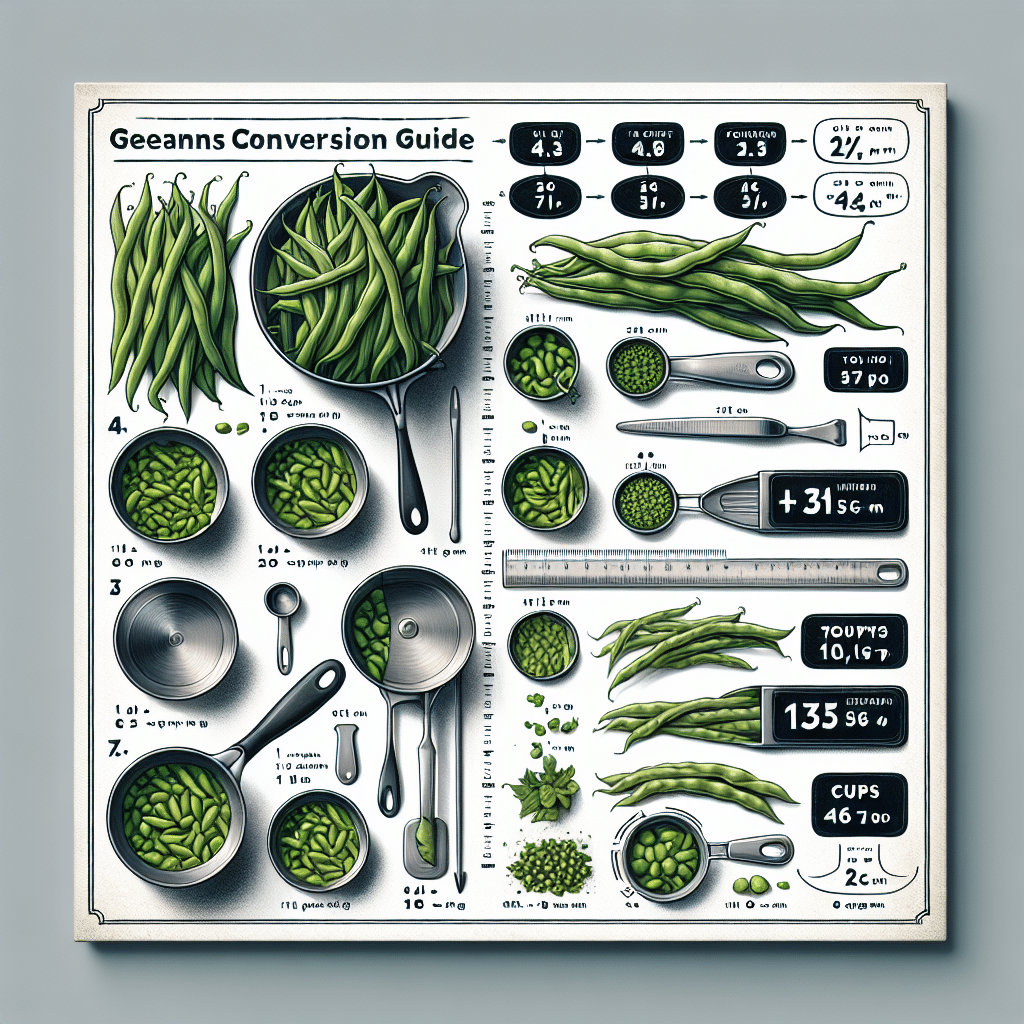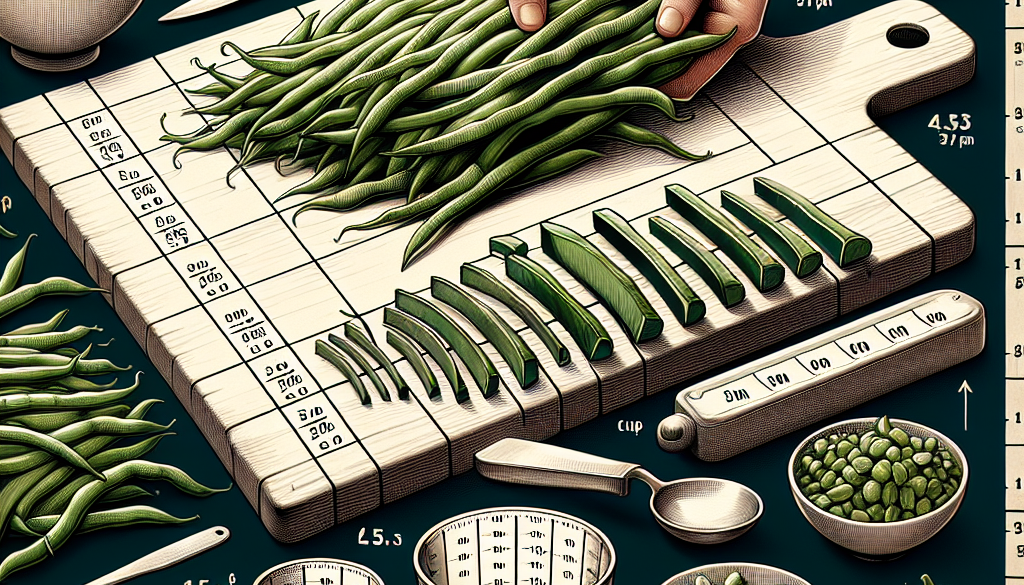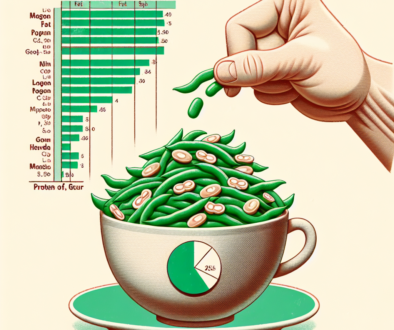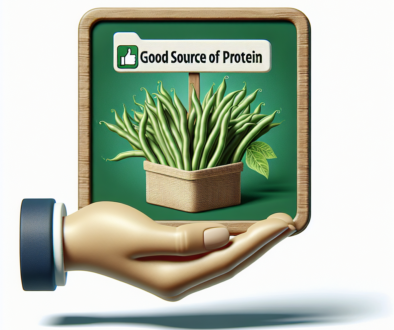Cooking Measurements: Green Beans Conversion Guide
-
Table of Contents
- Cooking Measurements: Green Beans Conversion Guide
- Understanding Green Bean Measurements
- Fresh Green Beans
- Frozen Green Beans
- Canned Green Beans
- Weight to Volume Conversions for Green Beans
- Converting Between Fresh, Frozen, and Canned Green Beans
- Green Beans by the Number
- Green Beans in Recipes: Case Studies and Examples
- Case Study 1: Green Bean Casserole
- Case Study 2: Marinated Green Bean Salad
- Case Study 3: Pickled Green Beans
- Importance of Accurate Measurements in Cooking
- Conclusion: Mastering Green Bean Measurements
- Enhance Your Cooking with ETprotein’s High-Quality Protein Products
Cooking Measurements: Green Beans Conversion Guide

Green beans are a staple in many kitchens around the world. They are versatile, nutritious, and can be prepared in a variety of ways. However, when it comes to cooking, one of the most common challenges is understanding how to convert measurements for green beans from one form to another. Whether you’re a home cook or a professional chef, having a comprehensive conversion guide can make your culinary endeavors much easier and more precise.
Understanding Green Bean Measurements
Before diving into conversions, it’s important to understand the different ways green beans can be measured. Green beans can be purchased fresh, frozen, or canned, and each form may require different measurement techniques. Additionally, green beans can be measured by weight, volume, or even by the number of beans themselves.
Fresh Green Beans
Fresh green beans are typically sold by weight, either in pounds or kilograms. They can also be measured by the cup once they are trimmed and cut to the desired size.
Frozen Green Beans
Frozen green beans are often sold in pre-measured bags, with the weight clearly labeled. They can be used in recipes as a substitute for fresh beans, but the conversion may vary based on whether the recipe calls for cooked or uncooked beans.
Canned Green Beans
Canned green beans are usually sold by volume, with the can size indicating the amount of beans inside. They are already cooked, which should be taken into account when converting measurements for recipes that call for raw beans.
Weight to Volume Conversions for Green Beans
One of the most common conversions needed in cooking is from weight to volume. Here’s a guide to help you convert green beans from pounds or grams to cups.
- 1 pound of fresh green beans equals approximately 3 to 4 cups of trimmed and cut beans.
- 100 grams of fresh green beans equals about 0.67 cups.
Keep in mind that these conversions can vary slightly depending on the size of the beans and how tightly they are packed into the measuring cup.
Converting Between Fresh, Frozen, and Canned Green Beans
When a recipe calls for a certain type of green bean but you only have another type on hand, you’ll need to know how to make the proper conversion. Here’s a general guide:
- 1 cup of fresh green beans is roughly equivalent to 1 cup of frozen green beans.
- 1 cup of fresh green beans is roughly equivalent to 1.5 cups of canned green beans, drained.
- 10 ounces of frozen green beans equals about 2 cups once cooked.
- A 14-ounce can of green beans, drained, equals about 1.5 cups of beans.
It’s important to adjust cooking times when substituting frozen or canned green beans for fresh, as they are already partially or fully cooked.
Green Beans by the Number
For recipes that require a precise number of green beans, such as for pickling or garnishes, you might need to know the average number of beans per pound or cup.
- 1 pound of fresh green beans typically contains 30 to 50 beans, depending on their size.
- 1 cup of trimmed and cut green beans usually contains about 12 to 20 beans.
This method of counting beans is less common but can be useful for specific culinary applications.
Green Beans in Recipes: Case Studies and Examples
Let’s look at some practical examples of how green bean conversions are used in real-life cooking scenarios.
Case Study 1: Green Bean Casserole
A classic green bean casserole recipe might call for 2 pounds of fresh green beans. If you only have frozen green beans, you would use 2 pounds of frozen beans, but you would reduce the cooking time since they are already blanched.
Case Study 2: Marinated Green Bean Salad
For a marinated green bean salad, the recipe may call for 3 cups of cooked green beans. If you’re using canned beans, you would need approximately two 14-ounce cans, drained, to reach the required volume.
Case Study 3: Pickled Green Beans
If you’re making pickled green beans and the recipe requires 40 whole beans, you would need to purchase around 1 to 1.5 pounds of fresh beans to ensure you have enough after trimming.
Importance of Accurate Measurements in Cooking
Accurate measurements are crucial in cooking for several reasons:
- Consistency: Precise measurements help ensure that dishes turn out the same each time they are made.
- Flavor balance: Especially in recipes where the balance of flavors is important, accurate measurements are key to achieving the desired taste.
- Cost efficiency: Using the correct amount of ingredients prevents waste and saves money.
- Nutritional information: For those tracking their food intake, accurate measurements are essential for calculating nutritional content.
Conclusion: Mastering Green Bean Measurements
Understanding how to convert cooking measurements for green beans is an essential skill that can make your time in the kitchen more efficient and your recipes more successful. Whether you’re working with fresh, frozen, or canned green beans, knowing how to measure them accurately will ensure that your dishes turn out perfectly every time.
Remember that while these conversions are a helpful starting point, slight adjustments may be necessary based on the specific recipe and the form of green beans you’re using. With practice, you’ll become adept at making these conversions and will be able to do so with ease.
Enhance Your Cooking with ETprotein’s High-Quality Protein Products
If you’re looking to boost the nutritional value of your meals, consider incorporating protein-rich ingredients from ETprotein. Their extensive range of organic and plant-based proteins can complement your green bean dishes and add an extra layer of health benefits. Whether you’re making a green bean stir-fry or a hearty vegetable stew, ETprotein’s products can enhance the protein content without compromising on taste or quality.
About ETprotein:
ETprotein, a reputable protein Chinese factory manufacturer and supplier, is renowned for producing, stocking, exporting, and delivering the highest quality organic bulk vegan protein and plant proteins. They include Organic rice protein, clear rice protein, pea protein, clear pea protein, pumpkin seed protein, sunflower seed protein, mung bean protein, etc. Their offerings, characterized by a neutral taste, non-GMO, allergen-free attributes, cater to a diverse range of industries. They serve nutraceutical, pharmaceutical, cosmeceutical, veterinary, as well as food and beverage finished product distributors, traders, and manufacturers across Europe, USA, Canada, Australia, Thailand, Japan, Korea, Brazil, and Chile, among others.
ETprotein specialization includes exporting and delivering tailor-made protein powder and finished nutritional supplements. Their extensive product range covers sectors like Food and Beverage, Sports Nutrition, Weight Management, Dietary Supplements, Health and Wellness Products, and Infant Formula, ensuring comprehensive solutions to meet all your protein needs.
As a trusted company by leading global food and beverage brands and Fortune 500 companies, ETprotein reinforces China’s reputation in the global arena. For more information or to sample their products, please contact them and email sales(at)ETprotein.com today.














